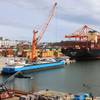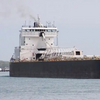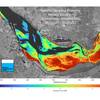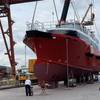NOAA Finalizes Plans for 2011 Survey Season
As the new year approaches, NOAA ships and independent contractors are preparing for the nation’s 177th hydrographic surveying season, aiming to collect critically needed ocean and coastal mapping data for 2,525 square nautical miles in high-traffic coastal waters of the continental United States and Alaska.
“The science of these surveys underpins the steady flow of commerce and the safety of mariners and coastal communities,” said NOAA Corps Capt. John E. Lowell, director of the Office of Coast Survey and U.S. national hydrographer. More than 13 million jobs are tied to maritime commerce which contributes more than $742 billion to the American economy.
U.S. waters cover 3.4 million square nautical miles including a constantly changing coastal environment due to storms, erosion and other coastal processes. To ensure the continued flow of commerce, NOAA’s Office of Coast Survey maintains the nation’s suite of more than 1,000 nautical charts. To ensure the accuracy of charts, the Office of Coast Survey annually plans hydrographic survey projects to update depths and identify new navigational hazards on the seafloor. Requests by marine pilots, port authorities, the Coast Guard, researchers and others are considered when setting the year’s schedule.
The surveys planned for 2011 will acquire data to update the country’s nautical charts, especially where marine transportation dynamics are changing rapidly. For instance, NOAA Ships Fairweather and Rainier plan to survey the coasts of Alaska in areas increasingly transited by the offshore oil and gas industry, cruise liners, ferries, military craft, tugs and barges, fishing vessels and factory trawlers.
Safety concerns also play a large role in project selections. One such project covers an area in the Strait of Georgia, Wash., where the largest oil tanker terminal in the state has recently doubled its capacity. In the Chesapeake Bay, data collected by NOAA Ship Thomas Jefferson will help address concerns about impacts of a planned pipeline. In addition, this project will provide broader benefit to the region.
“The timing for the southern Chesapeake Bay survey is really great — not only for commercial shipping but also for Operation Sail 2012,” said Captain Bill Cofer, president of the Virginia Pilots Association. The historic ship celebration could generate more than $150 million for the state through tourism and related activities.
Thomas Jefferson will also survey in eastern Long Island Sound to ensure that no navigational hazards exist in proposed anchorage grounds — areas for vessels to anchor while awaiting transit into ports in the area — while also supporting other ocean mapping initiatives in New York and Connecticut.
Because nautical charting surveys depict changes on the coastal ocean floor as well as depths and obstructions, the data is increasingly used by coastal managers to better understand ecosystem habitat, fisheries management and coastal planning. Surveys in Alaska, for example, will help build tsunami inundation digital elevation models for the state, and support the creation of digital seafloor maps for use by longline and pot fisheries.












